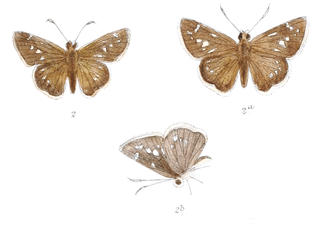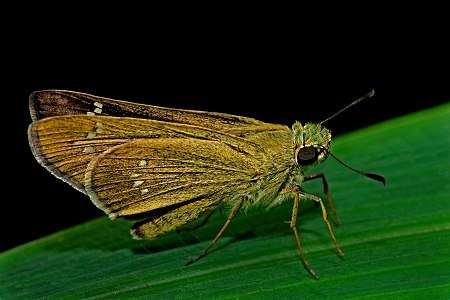Borbo bevani
Borbo bevani,[1] the Beavan's swift,[2] is a butterfly belonging to the family Hesperiidae. It is named after Captain Robert Cecil Beavan. It is found throughout India.[2][3][4]
| Beavan's swift | |
|---|---|
 | |
 | |
| Scientific classification | |
| Kingdom: | |
| Phylum: | |
| Class: | |
| Order: | |
| Family: | |
| Genus: | |
| Species: | B. bevani |
| Binomial name | |
| Borbo bevani (Moore, 1878) | |
| Synonyms | |
| |
Description
Male. Upperside dark olive-brown; cilia pale brownish-cinereous; forewing with a single small, pale white, semi-diaphanous spot at upper end of the cell, three contiguous subapical spots, another below these; and two larger spots below obliquely on the disc, a small spot also very indistinctly visible on middle of submedian vein; hindwing without spots. Underside greyish olive-brown; spots slightly more prominent than above; hindwing with a discal series of five small somewhat indistinct white spots.
Salween, Moulmein (Lt. Bevan). A male specimen of this species from Calcutta collected by the late Mr. Atkinson is in the collection of Dr. O. Staudinger. Also recorded from Karachi, Mhow, Poona and Bombay (Swinhoe); Calcutta (de Niceville); Orissa (Taylor); Nilgiris (Hampson). Mr. Elwes also states that he has specimens from Mandi, N.-W. Himalayas, Khasias, and Sikkim.
References
- Vane-Wright, R. I.; de Jong, R. (2003). "The butterflies of Sulawesi: annotated checklist for a critical island fauna". Zoologische Verhandelingen. 343: 76–77.
Note.–– Lee (1966) erected the monotypic genus Pseudoborbo for this species on the basis of differences in the male and female genitalia with other Borbo species. We do not accept this separation; a comparative study involving related genera is required to justify such an action.
- R.K., Varshney; Smetacek, Peter (2015). A Synoptic Catalogue of the Butterflies of India. New Delhi: Butterfly Research Centre, Bhimtal & Indinov Publishing, New Delhi. p. 56. doi:10.13140/RG.2.1.3966.2164. ISBN 978-81-929826-4-9.
- W. H., Evans (1949). A Catalogue of the Hesperiidae from Europe, Asia, and Australia in the British Museum. London: British Museum (Natural History). Department of Entomology. pp. 437–438.
-

-
